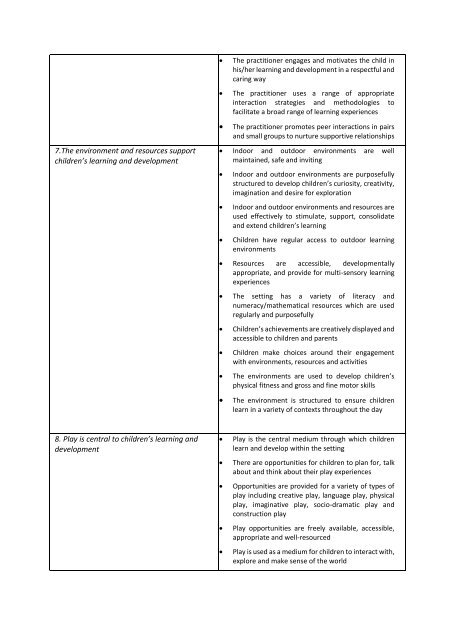A-Guide-to-Early-years-Education-focused-Inspection-EYEI-in-Early-years-Settings-Participating-ECCE-Programme
A-Guide-to-Early-years-Education-focused-Inspection-EYEI-in-Early-years-Settings-Participating-ECCE-Programme
A-Guide-to-Early-years-Education-focused-Inspection-EYEI-in-Early-years-Settings-Participating-ECCE-Programme
Create successful ePaper yourself
Turn your PDF publications into a flip-book with our unique Google optimized e-Paper software.
7.The environment and resources support<br />
children’s learn<strong>in</strong>g and development<br />
<br />
<br />
<br />
The practitioner engages and motivates the child <strong>in</strong><br />
his/her learn<strong>in</strong>g and development <strong>in</strong> a respectful and<br />
car<strong>in</strong>g way<br />
The practitioner uses a range of appropriate<br />
<strong>in</strong>teraction strategies and methodologies <strong>to</strong><br />
facilitate a broad range of learn<strong>in</strong>g experiences<br />
The practitioner promotes peer <strong>in</strong>teractions <strong>in</strong> pairs<br />
and small groups <strong>to</strong> nurture supportive relationships<br />
Indoor and outdoor environments are well<br />
ma<strong>in</strong>ta<strong>in</strong>ed, safe and <strong>in</strong>vit<strong>in</strong>g<br />
<br />
<br />
<br />
Indoor and outdoor environments are purposefully<br />
structured <strong>to</strong> develop children’s curiosity, creativity,<br />
imag<strong>in</strong>ation and desire for exploration<br />
Indoor and outdoor environments and resources are<br />
used effectively <strong>to</strong> stimulate, support, consolidate<br />
and extend children’s learn<strong>in</strong>g<br />
Children have regular access <strong>to</strong> outdoor learn<strong>in</strong>g<br />
environments<br />
Resources are accessible, developmentally<br />
appropriate, and provide for multi-sensory learn<strong>in</strong>g<br />
experiences<br />
The sett<strong>in</strong>g has a variety of literacy and<br />
numeracy/mathematical resources which are used<br />
regularly and purposefully<br />
<br />
<br />
<br />
<br />
Children’s achievements are creatively displayed and<br />
accessible <strong>to</strong> children and parents<br />
Children make choices around their engagement<br />
with environments, resources and activities<br />
The environments are used <strong>to</strong> develop children’s<br />
physical fitness and gross and f<strong>in</strong>e mo<strong>to</strong>r skills<br />
The environment is structured <strong>to</strong> ensure children<br />
learn <strong>in</strong> a variety of contexts throughout the day<br />
8. Play is central <strong>to</strong> children’s learn<strong>in</strong>g and<br />
development<br />
<br />
<br />
<br />
<br />
<br />
Play is the central medium through which children<br />
learn and develop with<strong>in</strong> the sett<strong>in</strong>g<br />
There are opportunities for children <strong>to</strong> plan for, talk<br />
about and th<strong>in</strong>k about their play experiences<br />
Opportunities are provided for a variety of types of<br />
play <strong>in</strong>clud<strong>in</strong>g creative play, language play, physical<br />
play, imag<strong>in</strong>ative play, socio-dramatic play and<br />
construction play<br />
Play opportunities are freely available, accessible,<br />
appropriate and well-resourced<br />
Play is used as a medium for children <strong>to</strong> <strong>in</strong>teract with,<br />
explore and make sense of the world


